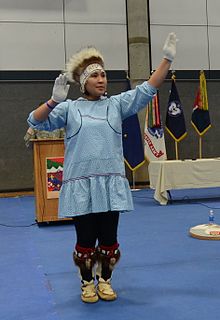
Back سكان الاسكا الاصليين ARZ Natius d'Alaska Catalan Indigene Völker Alaskas German Nativos de Alaska Spanish بومیان آلاسکا Persian Alaskan alkuperäiskansat Finnish Autochtones d'Alaska French Penduduk asli Alaska ID アラスカ先住民 Japanese 알래스카 원주민 Korean
This article needs additional citations for verification. (May 2018) |
 Alaska Native dancer performing in Fairbanks | |
| Total population | |
|---|---|
| ≈106,660 (2006)[1] | |
| Regions with significant populations | |
| Languages | |
| English, Alaskan Russian, Haida, Tsimshianic languages, Eskaleut languages (Inupiaq, Central Alaskan Yup'ik, Alutiiq, Aleut), Chinook Jargon, Na-Dené languages (Northern Athabaskan, Eyak, Tlingit), others | |
| Religion | |
| Shamanism (largely ex) Alaska Native religion, Christianity (Protestantism, Eastern Orthodoxy, Roman Catholicism) | |
| Related ethnic groups | |
| Alaskan Creoles, Native Americans, First Nations, Inuit |
| Part of a series on |
| Native Americans in the United States |
|---|

Alaska Natives (also known as Alaskan Indians, Alaskan Natives, Native Alaskans, Indigenous Alaskans, Aboriginal Alaskans or First Alaskans) are the Indigenous peoples of Alaska and include Russian Creoles, Iñupiat, Yupik, Aleut, Eyak, Tlingit, Haida, Tsimshian, and a number of Northern Athabaskan cultures. They are often defined by their language groups. Many Alaska Natives are enrolled in federally recognized Alaska Native tribal entities, who in turn belong to 13 Alaska Native Regional Corporations, who administer land and financial claims.
Ancestors of Native Alaskans or Alaska Natives migrated into the area thousands of years ago, in at least two different waves. Some are descendants of the third wave of migration, in which people settled across the northern part of North America. They never migrated to southern areas. Genetic studies show they are not closely related to native peoples in South America.
Alaska Natives came from Asia. Anthropologists have stated that their journey from Asia to Alaska was made possible through the Bering land bridge or by traveling across the sea.[2] Throughout the Arctic and the circumpolar north, the ancestors of Alaska Natives established varying indigenous, complex cultures that have succeeded each other over time. They developed sophisticated ways to deal with the challenging climate and environment.
Historical groups have been defined by their languages, which belong to several major language families. Today, Alaska Natives or Native Alaskans constitute more than 20% of the population of Alaska.[3]
- ^ Alaska Department of Workforce Development (2006). "Table 1.8 Alaska Native American Population Alone By Age And Male/Female, July 1, 2006."[permanent dead link] Alaska Department of Labor & Workforce Development, Research & Analysis. Retrieved on 2007-05-23.
- ^ "Alaska Natives, Alaska Kids' Corner, State of Alaska". alaska.gov. Retrieved September 27, 2021.
- ^ "U.S. Census Bureau Quick Facts". www.census.gov. 2017.